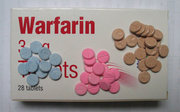PURPOSE: Warfarin, commonly used in pulmonary arterial hypertension (PAH) is a difficult therapy to use, requiring frequent and ongoing monitoring to achieve safe and effective anticoagulation, with dosing influenced by changes in diet as well as drugs. As an inducer of CYP2C9, bosentan (BOS), a twice daily, nonselective ETRA, interacts with the metabolism of warfarin. As an inhibitor of CYP2C9, sitaxsentan (SITAX), a once daily, highly ETA selective ETRA, also interacts with the metabolism of warfarin. Here, we report on the management of warfarin from a multi-center, placebo (PBO)-controlled study, STRIDE-2.
METHODS: STRIDE 2 included SITAX 100mg once daily, 50mg once daily, PBO, and an open-label, efficacy rater blinded, arm of BOS BID. BOS was dosed according to label. The protocol recommended that patients (pts) on warfarin randomized to SITAX or PBO were, at study entry, to have a single reduction in warfarin dose of 80%, followed by usual management. Pts on warfarin at study entry and randomized to BOS did not have warfarin dose adjusted. Warfarin doses at endpoint and the total number of dosing changes in the 18 week trial were assessed.
RESULTS: 47% of pts were on warfarin at study entry. Results for wk 18 mean warfarin dose and mean number of dose changes per pt are shown in Table 1.
CONCLUSION: Warfarin dose was higher in BOS pts and lower in SITAX pts than PBO, consistent with expectations. Nonetheless, warfarin dosing changes were equally frequent for pts treated with BOS, SITAX, or PBO, indicating no meaningful difference in management complexity.
CLINICAL IMPLICATIONS: Warfarin is a difficult therapy to use and requires frequent and continuous monitoring. The management of warfarin in patients with PAH is similar between no ETRA therapy and the use of either bosentan or sitaxsentan.
DISCLOSURE: Terrance Coyne, Employee Encysive Pharmaceuticals; Product/procedure/technique that is considered research and is NOT yet approved for any purpose. Sitaxsentan.
Terrance Coyne MD * Richard Dixon PhD Encysive Pharmaceuticals, Houston, TX
COPYRIGHT 2005 American College of Chest Physicians
COPYRIGHT 2005 Gale Group



